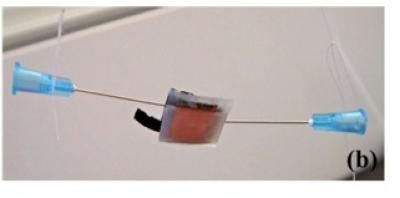Argonne breakthrough may revolutionize ethylene production
Scientists create environmentally friendly technology to produce commonly used compound
A new environmentally friendly technology created by scientists at the U.S. Department of Energy's (DOE) Argonne National Laboratory may revolutionize the production of the world's most commonly produced organic compound, ethylene.
An Argonne research team led by senior ceramist Balu Balachandran devised a high-temperature membrane that can produce ethylene from an ethane stream by removing pure hydrogen. "This is a clean, energy-efficient way of producing a chemical that before required methods that were expensive and wasteful and also emitted a great deal of pollution," Balachandran said.
Ethylene has a vast number of uses in all aspects of industry. Farmers and horticulturalists use it as a plant hormone to promote flowering and ripening, especially in bananas. Doctors and surgeons have also long used ethylene as an anesthetic, while ethylene-based polymers can be found in everything from freezer bags to fiberglass.
Because the new membrane lets only hydrogen pass through it, the ethane stream does not come into contact with atmospheric oxygen and nitrogen, preventing the creation of a miasma of greenhouse gases - nitrogen oxide, carbon dioxide and carbon monoxide - associated with the traditional production of ethylene by pyrolysis, in which ethane is exposed to jets of hot steam. The world's ethylene producers manufacture more than 75 million metric tons of ethylene per year, causing millions of metric tons' worth of greenhouse gas emissions.
Unlike pyrolysis, which requires the constant input of heat, the hydrogen transport membrane (HTM) produces the fuel needed in order to drive the reaction. By using air on one side of the membrane, the already-transported hydrogen can react with oxygen to provide energy. "By using this membrane, we essentially enable the reaction to feed itself," Balachandran said. "The heat is produced where it is needed."
The new membrane reactor also performs an additional chemical trick: by constantly removing hydrogen from the stream, the membrane alters the ratio of reactants to products, enabling the reaction to make more ethylene that it theoretically could have before reaching equilibrium. "We are essentially confusing or cheating the thermodynamic limit," Balachandran said. "The membrane reactor thinks: 'hey, I haven't reached equilibrium yet, let me take this reaction forward.'"
While Balachandran's team, which included chemists Stephen Dorris, Tae Lee, Chris Marshall and Charles Scouton, designed this experiment merely to prove the membrane's capability to produce ethylene, he hopes to extend the project by pairing with an industrial partner who would produce the membranes commercially. Since the membrane reduces the number of steps required to produce ethylene, the technology could enable the chemical to be produced more cheaply, he said.
Most read news
Other news from the department science
These products might interest you

Eclipse by Wyatt Technology
FFF-MALS system for separation and characterization of macromolecules and nanoparticles
The latest and most innovative FFF system designed for highest usability, robustness and data quality

HYPERION II by Bruker
FT-IR and IR laser imaging (QCL) microscope for research and development
Analyze macroscopic samples with microscopic resolution (5 µm) in seconds

Get the chemical industry in your inbox
By submitting this form you agree that LUMITOS AG will send you the newsletter(s) selected above by email. Your data will not be passed on to third parties. Your data will be stored and processed in accordance with our data protection regulations. LUMITOS may contact you by email for the purpose of advertising or market and opinion surveys. You can revoke your consent at any time without giving reasons to LUMITOS AG, Ernst-Augustin-Str. 2, 12489 Berlin, Germany or by e-mail at revoke@lumitos.com with effect for the future. In addition, each email contains a link to unsubscribe from the corresponding newsletter.




























































